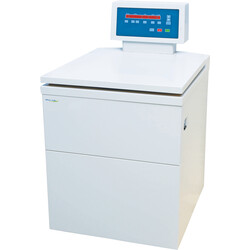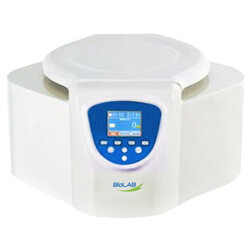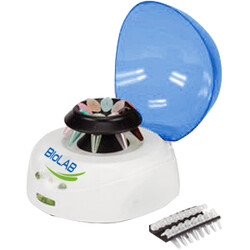Things To Consider Before Buying A Laboratory Centrifuge
In this article, we'll describe briefly the working of a centrifuge whilst underlining its critical elements, variation, and applicability.Centrifuge and its Principle
A centrifuge is a piece of machinery that, when spun, generates a substantial centrifugal force that separates the components of a sample according to their densities. Continuing in this direction after that are lighter particles. Small sediment particles classified as sediment pellets are driven to the tube's bottom. The residue solution or precipitate can then be analyzed or put through additional processes. The intensity of speed that is provided to the sample is defined as the relative centrifugal force (RCF), also knownas G-force. The particles will drift away from the axis of rotation and initiate sedimentation when RCF is higher than the forces of buoyancy and friction in the sample. It is a vital piece of laboratory equipment that is frequently required throughout the globe. Recognizing a centrifuge machine and the forces that operate it is essential to get the most of this equipment.
Parts of a Centrifuge Machine
Chamber - A chamber contains the complete system. The cups or shields that cover the rotor are enclosed in thecentrifuge head, which rotates on a spindle. The rotors are encompassed by a safety shield in the chamber.
Motor - A large motor that produces spin is in the center of the centrifuge.
Rotor – It is where the containers holding the tubes of the materials to be centrifuged will rest. Rotor speeds
produced by centrifuges are intended to facilitate the separation of sample components.
Lid - Any centrifuge without a lid should no longer be used, and the lid should not be retrofitted with a latch.
Latch - If a tube breaks or there are other issues while the centrifuge is running, the latch holds the lid closed.
Types of Centrifuges
We will go over some of the most common types of laboratory centrifuges on the market since this articleprimarily focuses on them.
1. Refrigerated Centrifuges –
The kind have a -20°C to -30°C temperature control range. There is a particular type of it that features a system for controlling the temperature, which is required for several treatments. They offer up to 60,000 xg of RCF, which is ideal for separating various biological components.

Refrigerated Centrifuge
A technology that is frequently used to collect components that separate quickly, such as yeast cells, chloroplasts, and erythrocytes. A cooled centrifuge's chamber is sealed from the outside to meet the needs of the operations.2. Benchtop (Tabletop) Centrifuges -
These are compact centrifuges which are excellent for smaller laboratories with lesser rooms and are frequently employed in clinical and research laboratories. It has a lid that covers the working unit of the centrifuge and a rotor with racks for the sample tubes. The tubes are rotated about a fixed axis by an electric motor, producing force perpendicular to the tubes.

Benchtop Centrifuge
3. Microcentrifuges -
The type is used to separate samples with lower volumes, ranging from 0.5 to 2 µl. The typical speed is between 12,000 and 13,000 rpm. The sample tubes used here, also known as microfuges, are smaller than the conventional test tubes used in larger centrifuges.

Microcentrifuge
Mostly employed for the molecular separation of DNA and cell organelles like nuclei.
For the operation of temperature-sensitive samples, microcentrifuges with temperature controls are offered.
Factors to be Considered for Buying a Centrifuge
1.RPM and RCF (G-Force) -One of the most crucial things while purchasing a centrifuge is the G-Force which is applied to the rotor and it must be taken into account while discussing the centrifuge's speed. As a result of which it decides which applications your centrifuge will control. Additionally, the RCF is influenced by the rotor's radius and its rate of swivelling. The RPM is also taken into account at the same time.
2. Capacity & Size -
Regarding capacity and size, a range of centrifuges are easily accessible. The maximum number of sample centrifuge tubes that can be placed within the centrifuge is determined by the centrifuge's capacity. As a result, various centrifuges can control various sample sizes.
3. Maintenance Credibility -
The centrifuge must be maintained in order for it to have a higher survival rate. As a result, we recommend you to have maintenance annually. The assessment of speed, brushes, temperature, etc. is regulated by maintenance.
4. Sealed rotors -
The sealed rotors are built-in to avoid the release of bio-hazardous materials while the centrifuge is in operation.
5. Rotor-recognition technology -
The installed type of rotor is recognized by the rotor-recognition technology. Furthermore, it assures that the rotor does not accelerate above the maximum speed needed.
6. Electric lid-lock -
While the centrifuge is operating, the electric lid-lock prohibits the lid from opening unexpectedly.
7. Accessibility of Replacement Parts -
One must ensure that replacement centrifuge parts are readily available before considering a centrifuge purchase.
8. Protection Features -
Since centrifuges must be used safely, several manufacturers have incorporated in the necessary precautions.
Applications
In laboratories, centrifuges can be applied in a variety of approaches.The following is an overview of some common applications for centrifuges -
1. In Biochemistry, Chemistry and Clinical medicine for isolating and separating immiscible liquids and suspensions.
2. In Clinical diagnosis and Pharmacogenetics in order to prepare DNA.
3. In Biological and Medical laboratories to concentrate cells and microscopic examination.
4. In clinical laboratories and research labs for protein, virus, cell, organelle, and nucleic acid cleansing.
5. Immiscible liquids separation
6. Separation of sediment suspended solids
7. Extraction of blood cells
8. Protein extraction
9. Isotope separation
10. In aeronautics, geotechnical testing, material synthesis and commercial applications.
In A Nutshell
Purchasing a centrifuge requires a significant upfront financial commitment depending on the number of units you require, the type of centrifuge you buy, and the accessories and customizations your laboratory needs; therefore, understanding centrifuges is essential.You May Also Like














